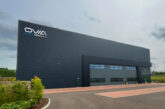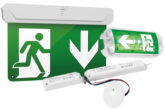
The code of practice for emergency lighting, BS 5266-1, has recently been revised and came into effect on the 31, May 2016. This article looks at the main changes to the standard which are applicable to non-domestic premises and common access routes within multi-storey dwellings.
Whilst emergency lighting recommendations are, primarily, intended to contribute to the safe evacuation of buildings on loss of the normal lighting, for some premises an immediate evacuation of all occupants may not be the most appropriate option in the event of a power supply interruption.
For example, evacuating all the residents from a care home may prove diffcult and involve safety risks. Therefore, the risk assessment may determine that it is more appropriate for the occupants to remain in the building for extended periods on loss of the normal lighting supply.
As a result the revised edition of BS 5266-1 includes recommendations and guidance for a ‘stay put’ strategy (Clause 4.1 refers).
For some premises, particularly those in locations vulnerable to frequent power supply interruptions, a ‘stay put’ strategy may be the most appropriate option. However, where premises implement such a system the safety of persons remaining in the premises must not be compromised.
For these reasons, Clause 4.1 recommends that any potential risks that may arise due to the loss of normal lighting should be assessed so that procedures for maintaining the safety of those remaining in the building can be determined, including the following:
- Actions that need to be taken as the end of the emergency lighting duration approaches
- How to warn occupants if evacuation is then needed
- How to direct or escort occupants to safe refuges.
Procedures may include retaining a proportion of the emergency lighting supply duration in case evacuation becomes necessary later on. Alternatively, trained personnel equipped with safety hand lamps complying with BS EN 60598-2-22 may assist occupants to a place of safety.
In view of this, information on emergency lighting technology, such as luminaires incorporating a rest mode facility which allows the emergency battery supply to be switched off when it is not needed, is contained in Annex B of the standard, and information on the application of emergency lighting systems is contained in Annex C.
An automatic test system is advised for premises that do not intend to conduct an immediate evacuation (Note 3 of Clause 4.1 refers).
Emergency safety lighting
To provide a safe environment for those who remain in the building, higher levels of illuminance and additional signage may need to be provided in particular areas or rooms. Lighting provided for such purposes is defined as Emergency safety lighting in BS 5266-1 and should satisfy the recommendations of Clause 5.3, as follows:
- It should provide a minimum illuminance of 1 lux over the floor area that people may need to cross, although based on risk assessment, higher levels may be needed (Clause 5.3.2 refers).
- Escape route and other safety signs should comply with Clause 5.2.9.1 and 5.2.9.2 respectively (Clause 5.3.3. refers). For example, an escape route sign designated as E001 and E002 in BS EN ISO 7010: 2012+A5 should be used with the appropriate directional arrow in accordance with Table 1 of BS 5499-4: 2013.
Servicing and repair of emergency lighting systems
The service and repair of emergency lighting systems is covered by Clause 13, which recommends that a competent person is appointed to perform the monthly test schedules. Furthermore, to minimise the time needed to complete essential repairs and reinstate emergency systems, it is recommended that any necessary spares, and in particular those that are difficult to obtain, are kept on site (Clause 13.4 refers).
Emergency lighting certificates
The model certificates have been updated to take account of the changes to BS 5266-1. For the verification of existing premises, a new model (site compliance) certificate is contained in Annex K, so the certificate designed for small emergency lighting installations, not exceeding 25 self-contained luminaires, is no longer a dual purpose certificate.
Verifying existing premises
Where valid emergency lighting system documentation cannot be provided for an existing installation, such as the original completion certificates, the installation should be inspected for compliance with current emergency lighting standards and a certificate of verification should be completed and supplied to the owner/occupier of the premises (Clause 11 of BS 5266-1 refers).
The intention is not to condemn a system due to lack of records, but instead to provide feedback to the owner/occupier of the premises, on the existing system. Identifying any deviations present and recommending the actions necessary to address them.
Such circumstances may arise as a result of, for example:
- The emergency lighting documentation having been lost.
- A change of usage or layout, for example, due to the conversion of an office into a restaurant the existing documentation may no longer remain valid.
- Improvements to safety standards (or technology) that, over time, have been incorporated into the emergency lighting standards, such as recommendations relating to high risk task areas and specific locations.
The completed verification certificate and associated documentation such as the log book and the records of remedial works will then provide a substitute system of documentation that may be used, when necessary, to provide evidence of compliance with current emergency lighting standards. Guidance on emergency lighting recommendations is provided in the NICEIC Snags and Solutions publication Emergency Lighting 3rd Edition, which has been specifically collated to complement the general recommendations given in the current version of the emergency lighting standard, BS 5266-1: 2016.
For information about the NICEIC Approved Contractor or Domestic Installers schemes visit: www.niceic.com








